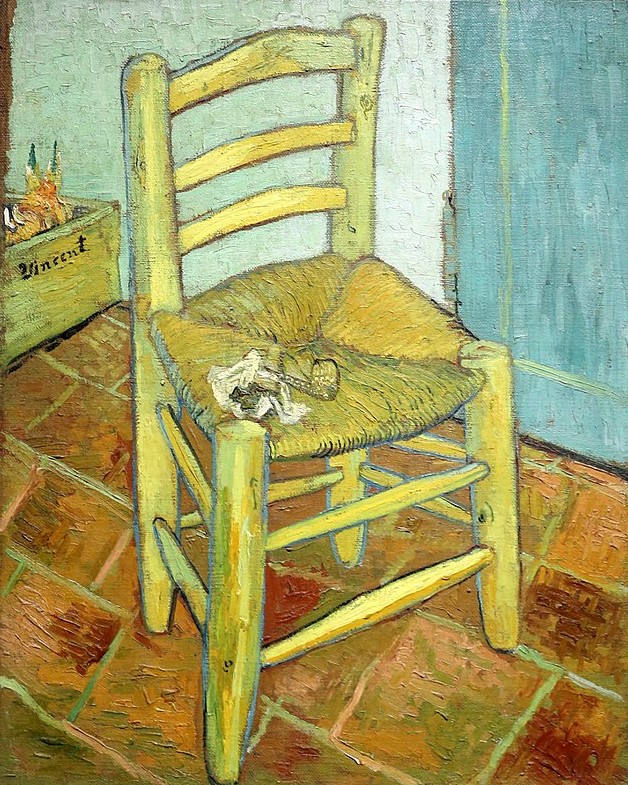
Mundane- Of this earthly world, lacking interest or excitement, dull.
Vincent Van Gogh was an ordinary man, living in an ordinary world, painting ordinary things. Why then, is his work seen as so extraordinary? The thing I hear most about Van Gogh’s work is how relatable it is. But most of his work is of objects and not of humans. It’s interesting to me that people seem to relate more to a field of crows, a vase of sunflowers, and a starry night rather than depictions of human beings. Why do these ordinary things seem to spark an intimate connection with viewers, causing us to personify and relate to these scenes of the mundane world?
It was midday and me and my four friends had just finished our tour of Westminster Abbey. It was an unusually sunny day in London as we walked down the crowded street. I was anxious to get to the National Gallery to see some famous works of art: Da Vinci, Rembrandt, Michelangelo, Van Gogh and many others. I mapped out a path through the gallery and our first stop was Da Vinci. His works were displayed in a small round room. It was full of people, but everyone was dead silent. When I walked in I felt the sacredness of the space. His work was so monumental. While my friends and I wandered through room after room filled with spectacular work, I stopped in front of a piece that was never finished; the exposed panel with nothing but a light sketch and a loose underpainting. I read the name of the artist, Michelangelo Buonarotti. I’d never seen an ‘in progress’ piece by one of the greats. I could see Michelangelo sitting right there with his brush, figuring out which color to put down next. Later, we walked into a room of dark, moody portraits done by Rembrandt. In the soft strokes of the faces, I saw the deepest, darkest parts of the people who sat as he painted them. I was trying to take in the overwhelming quantity of amazing work but was feeling saturated. We had one artist left that we needed to see, Van Gogh.
We walked into the room and it was by far the most crowded. A haphazard line formed so each person could have a chance in front of the paintings. We slowly made our way to his wall where four of his pieces hung. I felt rushed due to the popularity of his exhibit and I wished I had more time to really absorb his paintings. It was my turn and I shuffled in front of the first one. Van Gogh’s Chair. Up until this moment this painting had been my least favorite of Van Gogh’s, but when I stood there in front of it, it pulled me in and wouldn’t let go. I moved in closer and took in every brushstroke, my friend next to me whispered in awe, “It’s not even that good.” We were both struck by the simplicity of it and that at the same time it was so full of complexity. Van Gogh’s Chair caused me to feel this strange sense of sadness mixed with a kind of warm feeling, so familiar yet I couldn’t really place it. How could something so ordinary and universal as a chair, be so specific and personal? I snapped a picture of Van Gogh’s Chair before leaving the gallery.
Today, I looked back at the picture I took of Van Gogh’s Chair and I observed my thoughts about it. It was very childlike with bold outlines and a slightly distorted perspective. It seemed a little inexperienced and dull, and well, it was a chair. But it didn’t just look childlike, it felt childlike. That sad, warm feeling I had when I first saw it, that was nostalgia. It wasn’t just a chair anymore, it was my chair. I could feel the layers of paint on top of the old wooden chair. My hand finds that piece on the back I would always pick at, exposing the wood underneath. I could hear the creak of the seat when I climbed onto it. I could smell the cold stone floor and feel it’s uneven surface underneath my dirty, bare feet. I get the sense that the room is big, or maybe I’m just small? Are those toys I can see in the box behind the chair? My eyes stop when I see the pipe on the chair and that sadness finds me again. I’m only remembering, my nostalgia interrupted by the reminder of time and times gone by. The crisp air of childhood juxtaposed with the smoke of adulthood. Van Gogh somehow managed to paint my childhood, and more than that he painted me remembering my childhood. How did he do that? He took mundane things, ordinary moments and put magic in them. He gave them a narrative, a story. His work invites you to be there, to put your story into these moments. That is what makes his work powerful, personal and so relatable. So is his work really mundane?
Without Van Gogh’s vulnerability in creating a space for his audience and without their willingness to accept his invitation into this earthly world, we would just have a simple painting of a chair. In the end, the power lies within each one of us, because we put the magic in the mundane.
Millie Barlow October 1, 2019